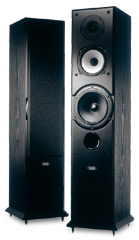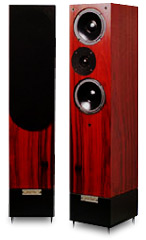 |
| March 15, 2003 Sound and Music: Two-and-a-Half-Way Loudspeakers In December’s column I looked at two-way speakers, citing both the super-compact BBC LS3/5A design, and the super-gigantic JBL K2 S9800, to illustrate the extreme contrasts within the most popular speaker configuration of all. The two-way design is a natural solution for bookshelf (stand-mount) speakers, but over the last few years the fashion trend has swung away from stand-mounts in favor of floorstanders. These relatively large loudspeakers tend to encourage designers to use extra drive units -- all the more so since the price of drive units has fallen quite substantially over the years. Furthermore, fashion is also dictating that these floorstanders should look nice and slim from the front, further encouraging the trend towards using lots of small drivers. It would seem logical that the next stage beyond the two-way is the three-way. Until quite recently, that would indeed have been the case. Three-ways do have their place in the scheme of things, and I’ll return to them in next month’s feature. But the last decade or so has seen the emergence, mainly among European brands, of a relatively new speaker configuration, usually known in the trade as a "two-and-a-half-way." This provides a useful "halfway house" between the two- and three-way designs, and is well suited to the currently fashionable, slim compact floorstanders, and also to the relatively new center-channel speakers used for multichannel home theater. Technically speaking, the two-and-a-half-way is a whole lot closer to a two-way than a three-way. Typically, instead of using, say, an 8" bass/mid (main) driver alongside a 1" tweeter, the two-and-a-half-way will have two 6.5" main drivers, often identical, one operating as a bass/mid unit all the way up to the tweeter, with the other merely operating over the bass region. In practice, this means that the combination is larger than an 8-incher through the bass region, where a large cone area is a real advantage, yet smaller in the upper midband, where a small cone tends to work best. A major plus with the two-and-a-half-way is that the crossover is almost as simple as a two-way -- one extra choke to roll off the bass-only driver being the only difference in some designs -- whereas a three-way crossover tends to be a much more elaborate affair. The downside is that, unlike the three-way, the two-and-a-half-way doesn’t offer any significant power-handling or loudness-capability advantage over the two-way. This is very much a trade-off situation. Certainly at normal volumes the advantage tends to lie with the simpler two-and-a-half-way, which usually have better time-coherence, and in practice today’s drive units are rugged and go pretty loud. Those who want to play heavy dance music at high levels -- or movies, for that matter -- in large spaces might be better off with a three-way. Two-and-a-half-ways are usually modestly priced, compact floorstanders, yet you will also encounter them among upmarket flagship models. Among the less expensive, one of my personal favorites is from the French brand JMlab, which makes its own highly respected drive units under the Focal banner. Its Chorus 715 is a classic example of an economical vinyl-finished box fitted with two high-class 6.5" drivers plus a titanium inverted-dome tweeter, giving a lively, full-bodied sound at a relatively modest price.
Moving up into true Ultra Audio territory, Wilson Benesch’s seven-driver Chimera takes the two-and-a-half-way to its logical and possibly ultimate conclusion: two separate high-tech enclosures, fabricated from a mixture of metal and carbon-fiber composite, are permanently fixed together. The larger, lower bass-only section has four of the company’s Tactic drivers mounted as isobaric, clamshell pairs, and port-loaded through the base. The upper section has a single forward-facing Tactic for bass/mid duties, while another Tactic faces downward into the gap between the two enclosures. The latter is not connected to the crossover or amplifier in any way, but rather acts as an ABR (a mechanical port), a resistor across the voice coil providing electromagnetic damping. There is another speaker configuration relying on multiple main drivers, usually referred to as a D’Appolito (after the Italian engineer who first codified the approach). It’s actually a straight two-way, with twin identical bass/mid drivers placed above and below a single tweeter, part of the theory being that the acoustic centers of the twin main drivers and the tweeter are coincident. The D’Appolito’s strength lies in being at least as simple as the two-and-a-half-way, though it does have certain qualitative differences. First, placing a main driver above a tweeter that is itself at seated ear height results in a necessarily tall loudspeaker. And while the basic crossover network ought to be as simple as any normal two-way, in practice there’s a slight snag. Whereas the conventional two-way merely has to combine the outputs of two point sources, the D’Appolito has to combine the twin main drivers’ "line source" with the tweeter’s "point source." The complication is that the line source has a different sound distribution pattern (cylindrical rather than spherical).
Even more extreme are new models from Neat Acoustics, like the Ultimatum MF9. Neat has always favored two-ways, and the MF9 manages to use a total of nine drive units all told. Six are 6.5" main drivers -- four making up a double D’Appolito on either side of a central tweeter, with two more providing isobaric loading inside the multi-cavity enclosure. (The final two are planar supertweeters mounted on the top surface facing upwards.) There’s an increasing and surprising variety of choices available between the traditional two-driver two-way and the much more complex three-way. Fashion and cosmetic presentation have both had a substantial influence on the scene, while the falling price of drive units has been a major factor in providing designers with the freedom and opportunity to experiment with and exploit new speaker configurations. ...Paul Messenger
Ultra Audio is part of the SoundStage! Network. |
 However, there’s no
reason the two main drivers in a two-and-a-half-way should be identical. Acoustic
Energy’s budget-priced AEGIS EVO Three (right) combines a 6.5" bass driver with
a 5.25" for bass/mid, a very sensible arrangement, which might not help the power
handling but should improve the vital mid-to-treble crossover transition. B&W’s
budget DM603 Series 3 might use two 6.5-inchers, but the bass-only unit here has a metal
cone, while a Kevlar cone handles bass/mid duties, using a material that has smoother
roll-off and dispersion characteristics at the top of its working range. Monitor
Audio’s Silver S8 presents three apparently identical, shiny metal-cone 6.5-inchers
to the world -- only the upper one carries out the bass/mid duties, while the other two
are simply used to provide extra muscle through the bass region.
However, there’s no
reason the two main drivers in a two-and-a-half-way should be identical. Acoustic
Energy’s budget-priced AEGIS EVO Three (right) combines a 6.5" bass driver with
a 5.25" for bass/mid, a very sensible arrangement, which might not help the power
handling but should improve the vital mid-to-treble crossover transition. B&W’s
budget DM603 Series 3 might use two 6.5-inchers, but the bass-only unit here has a metal
cone, while a Kevlar cone handles bass/mid duties, using a material that has smoother
roll-off and dispersion characteristics at the top of its working range. Monitor
Audio’s Silver S8 presents three apparently identical, shiny metal-cone 6.5-inchers
to the world -- only the upper one carries out the bass/mid duties, while the other two
are simply used to provide extra muscle through the bass region. One of the first D’Appolitos I
encountered was the model 104 from Danish brand Dali. More recent examples include the
Magnat Vintage 320 from Germany, and an M74 from the British brand Mission. Although these
are relatively affordable models, D’Appolitos also command serious prices. Living
Voice’s Avatar OBX-R (right) combines an essential simplicity with the finest-quality
ingredients, including external crossovers.
One of the first D’Appolitos I
encountered was the model 104 from Danish brand Dali. More recent examples include the
Magnat Vintage 320 from Germany, and an M74 from the British brand Mission. Although these
are relatively affordable models, D’Appolitos also command serious prices. Living
Voice’s Avatar OBX-R (right) combines an essential simplicity with the finest-quality
ingredients, including external crossovers.